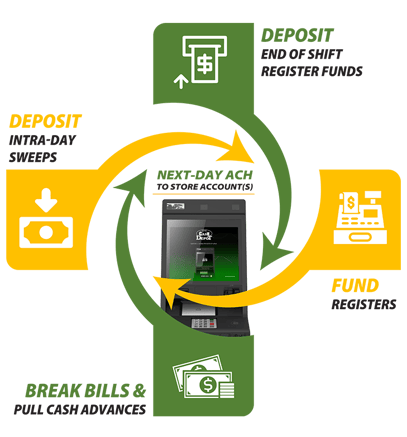3 Ways Retailers Can Seek More Cost-Effective Cash Management
Ugh. Cash. There is a reason a rash of retailers have been experimenting with cashless locations, despite sacrificing a portion of their profits to alternative payments fees. And a huge part of that is the growing inconvenience and cost of cash.
The time it takes to count it. The effort it takes to track it. The way criminals target it. Not to mention how banks are increasingly charging for deposits and inflation has increased the costs of transporting it.
But just as managing cash has become more burdensome, so too, has technology arisen to alleviate those concerns. Here are five ways convenience and grocery retailers can seek more cost-effective cash solutions.
Deter cash theft and improve security.
Oh, we’ve all heard the song and dance about how keeping money in a safe and reducing drawer cash reduces the costs of theft. They’re not wrong. As criminals rely on speed to achieve their score and avoid law enforcement, any barriers available to decrease the reward also deter the crime.
 No matter what cash management system is being used, having at least one day’s worth of operational money set aside is good practice. But many retailers also have to keep a slush fund of smaller bills for when registers have to provide change for larger notes or run low on ones, fives, or tens. And the more change kept on hand, the larger the potential payoff for the “bad guys”.
No matter what cash management system is being used, having at least one day’s worth of operational money set aside is good practice. But many retailers also have to keep a slush fund of smaller bills for when registers have to provide change for larger notes or run low on ones, fives, or tens. And the more change kept on hand, the larger the potential payoff for the “bad guys”.
Cash recyclers resolve some of this problem by offering a safe system and location to automatically deliver start-of-shift funds or mid-day cash provision. And, like smart safes, they have the ability to store excess cash to help keep the money held in each register at a minimum.
But, if limiting available register funds and accessible back-office cash lowers temptation, what would happen if your cash management system could reduce the TOTAL amount of cash available in the entire store without curtailing your ability to accept physical currency?
Systems like BANK IN A BOX allow stores to take a step beyond cash storage, truly recycling currency back to consumers as they use the machine’s built-in ATM and financial services functionality. While the store funds registers, splits bills, and deposits cash, money is counted, verified, and made available for customers for ATM withdrawals. Withdrawals are made available in multiple denominations – making it easy to cycle large bills out of the store fast.
Improve employee/store efficiency and use of employee time.
Traditional, manual cash management for convenience stores can average 18-23 hours per week. Retailers such as grocery that handle even more cash will usually spend even more time on cash counting and reconciliation.
But even at 18 hours per week, retailers paying the federal minimum wage ($7.25) are investing $520-680/month in labor – not including additional costs for managers and cash transportation. However, most states have raised their wage requirements beyond the federal standard, typically somewhere between ten and fifteen dollars per hour. The result is additionally increased manual cash costs, often reaching $720-$1,380 a month.
Implementing an automated cash management system with recycling capabilities eliminates a good portion of the time and effort required to count, prepare, and maintain a retail cash program. Recycling systems like BANK IN A BOX are able to accurately count, record, and report both start-of-shift funds as well as end-of-shift and other daily deposits. And real-time reporting saves even more time, letting managers and corporate offices see ongoing activity as well as pull detailed reports to quickly compare against point-of-sale data.
Reduce cash handling fees.
Did we mention banks charging for deposits? Yes, yes…not all banks. Or only over a certain deposit amount. Or only if you deposit a certain way. Or only if you make more than a certain number of deposits within the month. But it’s all very frustrating, isn’t it?
You have to find the right bank that will accept the right amount of cash the correct number of times in a way that suits your business. Either that or cater to the whims of your bank, limiting deposits, methods, or imposing other restraints to avoid the fees. It’s hardly surprising so many retailers have turned to armored carriers.
You see, banks have been increasing their fees for commercial deposits to pay for their own cash management processes. But, as their core business has increasingly become the electronic movement of funds, most branches would rather not have to deal with the counting, verification, and transportation of physical currency.
Using an armored carrier alleviates bank fees by taking over the responsibility for the transportation and ownership of the cash. Rather than dealing with all of the processes associated with cash management, your bank does what it does best, process an electronic funds transfer.
But, while the charges from the bank disappear, the trade-off is paying the armored carrier costs. Today, industry standards average around $60 per pick-up, or around $240 per month at one pick-up per week. However, prices vary by region and carrier due to fees, mileage, fuel costs, etc. and inflation has many carriers looking at pricing increases as their contracts renew over the coming years.
Smart safe and recycler cash management systems are often coupled with armored carriers, depending on the service selected. Placement programs, for instance, usually have the option to include armored pick-up along with equipment, maintenance, software, and reporting. However, while it is also possible to hook in armored as part of a purchase option, availability depends on the company providing the cash management equipment and service.
But, while standard cash management systems can reduce or eliminate some of the banking fees and difficulties, they occasionally add in some fees of their own – like provisional credit.
Convenience stores, grocery, and other retailers who manually handle cash deal with a constant disconnect between the date of a deposit and the time the money is available in a bank account. Those businesses using armored carriers, smart safes, or cash recycling systems are not different. Always there is a time period between the time of pick up and the electronic deposit into an account.
Provisional credit is designed to bridge that gap. It uses the cash management system’s reporting to essentially loan the money until the actual bank deposit is made. But, like a loan, there is a percentage charged for every dollar. And, with the Federal Reserve continuing to raise interest rates (5.25% as of this writing), provisional credit rates have also seen significant increases over the last year and a half.
However, not all cash management programs rely on provisional credit to keep cash flow steady. True cash recycling systems like BANK IN THE BOX are able to automatically audit and purchase machine cash daily. This daily accounting lets the system verify funds without all the hassle of removing the currency from the machine. And a next-day electronic transfer keeps accounts funded without the worry about increasing provisional credit costs.
So, that's it? Get a machine?
No, of course not. There are certainly retailers who don’t accept enough daily cash transactions for a change in cash handling to make a difference. There are even financial institutions that work with their commercial account holders to limit fees and help them manage their funds well. And, you know, not every retailer is suffering staffing shortages, rising wage costs, or increased criminal threats.
So, no, a smart safe, cash recycler, or even BANK IN A BOX is not going to be a one-size-fits-all solution. But, if you’re sick of the time and cost of managing your cash? It might be worth a look.




